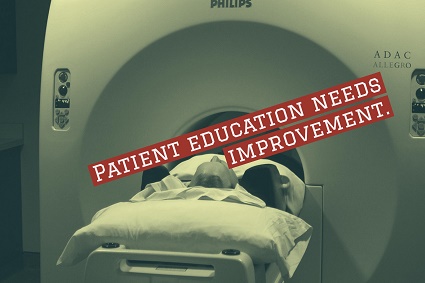Your cart is currently empty!

Patient Education: A New Study
A recent study in the American Journal of Roentgenology shared some disheartening data about online patient education. The good news is that more than 50% of the American hospitals and clinics that offer mammograms also had some online patient education materials about mammography.
If that doesn’t sound particularly good, I’m with you. Out of over 4,000 healthcare facilities surveyed, only 54% had patient education materials available on their websites. That’s over half, strictly speaking, but we’d have preferred to see a number closer to 100 than to 50.
It gets worse.
- Of those 4,000 plus healthcare facilities, only 28% referred patients to any standard guidelines (such as those of the American Cancer Society, for example).
- A mere 0.4% of the facilities had patient education materials at the recommended 7th grade readability level. The average readability scores were 10th to 14th grade — that is, a high school senior or a college sophomore could read the information, but not a person with limited English who needed to make an informed decision.
- 212 of the websites had fewer than 100 words. This is not enough to communicate clearly with search engines, let alone to help patients understand a subject as complex as mammography. These websites — and of course the facilities which did not have websites — were excluded from the study. That means that, from a patient’s point of view, the availability of the information was actually worse than the numbers suggest.
“Given the many controversies surrounding screening mammography, nuanced information about mammography guidelines may already be difficult for many patients to understand,”the authors pointed out. There is real controversy over mammograms, and casual reporting has led to a high level of confusion and uncertainty among American women. This makes patient education on this topic particularly important.
But patient education is always important.
David Meerman Scott, reporting data presented at the 2012 National Healthcare Marketing Summit, wrote, “80 percent of internet users look up healthcare information online, yet 64 percent of hospital marketing departments devote less than 25% of their marketing budgets to interactive content… Hospital marketers are busy making brochures and TV ads instead of creating thoughtful web content.”
Chances are good that many healthcare facilities’ marketing staff don’t think of themselves as responsible for patient education. But chances are also good that the 4,000 plus healthcare facilities in the study being discussed here had web content which was largely overseen by their marketing staff. Or possibly their IT department. Or their ad agency.
“We can’t just pass mammography education off to hospital website people,” one of the study’s lead authors said to radiology site Aunt Minnie. The uncertainty of “hospital website people” suggests that it’s time to think seriously about the place of websites in patient education.
Here at Haden Interactive, we work directly with physicians, as well as with health care marketing directors and communications officers, to make certain that we provide the kind of patient education content they need. Here are some things to look for when you examine your practice’s or facility’s online patient education materials:
- Do they reference the standards your facility uses? Different professional organizations and government agencies may provide different standards. While only 28% of the facilities in the study discussed here referred to any standards at all (and 3% of those just mentioned “guidelines” without specifying or linking to any particular set of guidelines), it’s important that your web team refers to the guidelines your organization supports.
- Do they use readability testing tools? We use the Yoast readability tester, which is based on the classic Flesch scale. This tool automatically rates content as it is written and helps writers ensure that they reach the appropriate reading level. If your writers go by feelings, take the time to run some of your content through a readability tester and find out. It’s a fair bet that none of your staff reads at a 7th grade level, so you may have trouble deciding for yourselves.
- Do they write well? You want your information to be accessible, but it also has to be worth reading. Otherwise, your patients probably won’t read it, whether they can do so easily or not.
This study is a striking one, and uses current data, but it doesn’t stand out from the pack. An article in the Journal of Arthroplasty (“Readability of Online Patient Education Materials on Adult Reconstruction Web Sites”) found that only 2% of the materials surveyed were at the recommended level of readability. A study reported in the American Journal of Otolaryngology found that the average patient education materials in their field were written at just slightly higher than an 11th grade reading level. It’s understandable that people specializing in fields with names that are meaningless to the average patient (and my spell checker, for that matter) might have trouble with readability. Neither of these studies reported on the number of their colleagues who didn’t have any significant amount of patient education content at all.
But it’s time to change that. Start with your own website. We’ll be happy to help.
by
Tags:

Leave a Reply